Counter Uncrewed Aerial Systems Sandbox 2024
Suffield, Alberta
May 27 - June 21, 2024
How might we detect and/or defeat Micro and Mini Uncrewed Aerial Systems (UAS) with systems that can be integrated into the broader military command and control system?
And the 2024 CUAS Sandbox prize winners are…
Three “Diamond in the rough” prizes are being awarded this year to the top innovations to detect and/or defeat micro and mini uncrewed aerial systems (UAS).
The IDEaS program is pleased to congratulate the winners of the 2024 Counter Uncrewed Aerial Systems (CUAS) Sandbox:
1st place ($1 million)
- AIM Defence (Vancouver, British Columbia)
2nd place tie ($375,000 each)
- DARIT Technologies (Sherbrooke, Quebec), and
- Prandtl Dynamics (Toronto, Ontario)
The 2024 CUAS Sandbox event took place from May 27 - June 21 at CFB Suffield in Alberta and featured 15 innovators from five countries who demonstrated and tested their counter-drone technologies. Innovators received feedback from various defence experts and end users, and the DND/CAF was informed to the art of the possible in CUAS technology developments.
Innovators, experts, & end-users
The following innovators have been selected to demonstrate their solutions at the 2024 CUAS Sandbox.
| - | Participating innovators | Country | Proposal type | Solution name | Solution description |
|---|---|---|---|---|---|

CaptionAIM Defence’s Fractl:1 Tactical CUAS |
AIM Defence | Australia/Canada | Defeat only | Fractl:1 Tactical Counter Uncrewed Aerial System (CUAS) | Surgically strikes and neutralizes quadcopters at one-kilometre ranges, as well as utilizes AIM’s latest generation of ultra-compact high power laser technology and precise AI tracking algorithms. |

CaptionAréte’s Basilisk |
Areté | USA | Detect only | Basilisk | Low SWaP-C passive sensor for detecting, tracking, and identifying drones. Allows CUAS detection / tracking without relying on RF emission of the drone, or radar emission from the sensor. |

CaptionDARIT Technologies’ AIMS |
DARIT Technologies | Canada | Detect only | Air Intrusion Monitoring System (AIMS) | Real-Time detection and 3D tracking of rotary drones using acoustics, cameras, and AI. Localizes and tracks simultaneously and in real-time. |

CaptionEOS Defence Systems’ Titanus CUAS |
EOS Defence Systems PTY Limited | Australia | Detect & Defeat | Titanis CUAS | Fully integrated counter-drone system with soft, hard, and directed energy kill capabilities to provide a layered protection against UAS threats. |
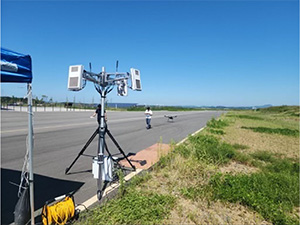
CaptionFortem Technologies / Arcfield Canada Corp’s Skydome CUAS |
Fortem Technologies/Arcfield Canada Corp | USA/Canada | Detect & Defeat | SkyDome CUAS | Detect/defeat CUAS solution that combines RF and non-RF (radar) detection, sophisticated AI-driven Command and Control, and a hard kill/soft kill defeat solution into a system that can operate in Fixed, Mobile and Portable roles. |
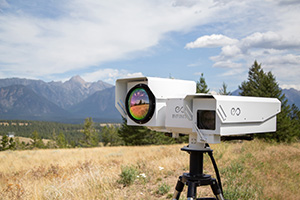
CaptionInfiniti Electro Optics’ drone camera system |
Infiniti Electro Optics | Canada | Detect only | Vega Ultra Long-Range Multi-Sensor PTZ Camera System | Military-grade multi-sensor EO-IR PTZ camera featuring industry-leading range and resolution, alongside advanced thermal infrared options. |
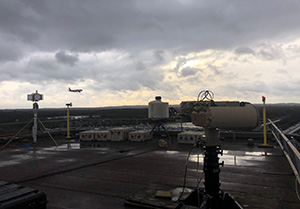
CaptionLeonardo Canada’s Falcon Shield counter-drone system |
Leonardo Canada | Canada | Detect & Defeat | Falcon Shield | An in service, operationally proven, rapidly deployable, scalable, and modular system designed to address the threat from low, slow uncrewed air systems. |

CaptionLiveLink Aerospace Ltd’s AERONETICS |
LiveLink Aerospace Ltd | UK/Canada | Detect & Defeat | Agile Electronic Reconnaissance and Operational Network for Enhanced Tactical Intelligence and Countermeasures (AERONETICS) | Employs an advanced defence matrix, seamlessly integrating passive RF detection, AI-driven electro-optics, and precision passive acoustics to autonomously detect, identify and track, giving an enhanced air picture. |
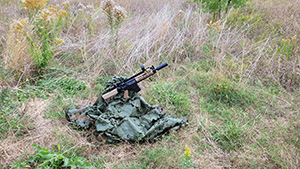
CaptionNominal Controls Inc.’s Tactical Close-Range CUAS |
Nominal Controls Inc. | Canada | Defeat only | Tactical Close-Range CUAS | A small-scale, localized point-defence system, best used for the kinetic defeat of UAS at a close range. |
| N/A | Prandtl Dynamics (University of Toronto) | Canada | Detect & Defeat | MUDDS: Meteorological Ultrasonic Drone Destruction System | An innovative technology that uses specialized ultrasonic waves to target and disrupt the gyroscopes of drones to disable control. |
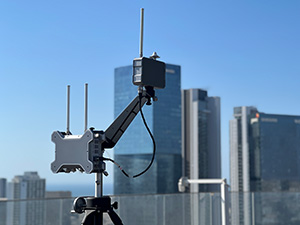
CaptionSentrycs, Inc.’s CUAS solution |
Sentrycs | USA/Israel | Detect & Defeat | Sentrycs CUAS solution | Protects the airspace from unauthorized drone traffic – tracking, monitoring and if necessary, mitigating the drone by taking control and safely landing the drone in a location determined by law enforcement or the military. |
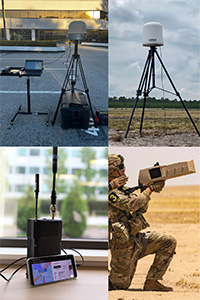
CaptionSkycope Technologies Inc.’s CUAS solutions |
Skycope Technologies Inc. | Canada | Detect & Defeat | Comprehensive, rapidly deployable, and different form-factor CUAS solutions | Includes three detection units of different form factors and applications (fixed/temporary deployment, vehicle mount/naval, and dismounted personnel). |
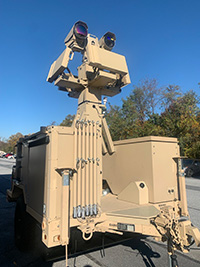
CaptionTeledyne FLIR’s Cerberus XL |
Teledyne FLIR | Canada | Detect & Defeat | Cerberus XL | A rapidly deployable mobile drone detection and mitigation solution including radar, video, RF detection, classification, automated tracking and mitigation. |

CaptionThe Boeing Company’s Mobile Compact Laser Weapon System (M CLWS) |
The Boeing Company | USA | Defeat only | Mobile Compact Laser Weapon System (M CLWS) | An affordable, rugged and reliable counter-UAS solution leveraging combat-proven high energy laser technology. |
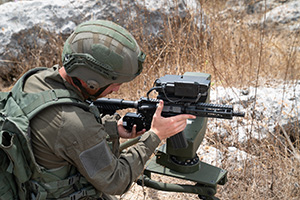
CaptionTwenty20 Insight Inc.’s Smash Hopper counter-drone weapon station. |
Twenty20 Insight Inc. | Israel | Defeat only | Smash Hopper | Light-weight Remote Controlled Weapon Station (RCWS) using SMASH Fire Control technology provides operators the remote capability to engage ground targets and small uncrewed aircraft systems. |
| DND/CAF/RCMP subject-matter experts and end-users |
|---|
| Canadian Joint Operations Command |
| Canadian Army |
| Royal Canadian Navy |
| Royal Canadian Air Force |
| Canadian Special Operations Forces Command |
| Defence Research and Development Canada |
| Royal Canadian Mounted Police |
| US Department of Defense Irregular Warfare Technical Support Directorate |
The challenge
Building on the results of the 2022 CUAS Sandbox, the Department of National Defence (DND) and the CAF and its defence and security partners (RCMP, public safety, etc.) are seeking CUAS solutions that can detect and/or defeat Micro and Mini UAS with systems that can be integrated into the broader military command and control systems, with an emphasis on hard-kill options.
New in 2023!
- Sandbox prizes will be awarded, with $1 million for first place, $500,000 for second place, and $250,000 for third place. This will be based on the solution of the innovator’s concept as demonstrated at the Sandbox, combined with short-term growth potential which the DND/CAF expects to see at the CUAS Sandbox 2026.
- In addition to the Sandbox, DND/CAF is looking for low Technology Readiness Level (TRL) 1-5 game-changing CUAS concepts that may be funded for development. See NEW – CUAS Concept development tab on this page.
Background and context
The UAS landscape is rapidly evolving. The rapid increase of availability, affordability, complexity, and capabilities of UAS systems is posing increasing threats to the DND/CAF and our defence and security partners. Potential adversaries are also adapting UAS designs to evade current CUAS capabilities, by reducing the UAS visibility, minimizing radio-frequency emissions, increasing autonomy, operating at higher velocities, etc., thus rendering the current CUAS approaches obsolete. Proposed solutions to this challenge should take into account not only what is available and a threat today, but also emerging UAS and CUAS capabilities and how they might be detected, defeated, and/or exploited tomorrow.
CUAS was identified as one of the priorities in Canada’s 2017 defence policy Strong, Secure, Engaged (SSE) which stated: “As the development of remotely piloted systems increases… Canada will require the appropriate capabilities to identify and defend against these burgeoning threats.” (page 73).
The Canadian Joint Operations Command (CJOC) is leading the CUAS effort, coordinating with the Canadian Army (CA), Royal Canadian Navy (RCN), Royal Canadian Air Force (RCAF), and Canadian Special Operations Forces Command (CANSOFCOM). The information presented in this IDEaS CUAS challenge represents a blending of characteristics of interest to one or more of the services, as well as the RCMP.
The following CAF projects have a direct interest in CUAS systems and the results of this challenge:
- Canadian Forces Land Electronic Warfare Modernization (CFLEWM). CFLEWM is upgrading the Army’s Mobile Electronic Warfare Teams in Light and Armoured platforms. While dedicated CUAS capabilities are out of scope for CFLEWM, a beneficial outcome would be to understand how multi-role EW Sense and Attack capabilities can contribute to the CUAS fight, and how dedicated CUAS sensors could be integrated into the EW sensor network.
- Land Intelligence, Surveillance and Reconnaissance Modernization (Land ISR Mod). Land ISR Mod is investigating capabilities that are capable of providing sensor systems for the purposes of targeting. This project is mandated under SSE Initiative #42 and is funded. This project is in Options Analysis transitioning to Definition.
- Counter Uncrewed Aerial Systems (CUAS). A specific CUAS initiative is investigating CUAS systems capable of defending critical infrastructure, vehicles, and personnel from Micro and Mini UAS. This project is not funded at this time, and consequently an intended date for any future procurement cannot yet be stated.
CUAS outcomes
Essential outcomes
Aside from addressing the challenge in an overall sense, there are no specific detailed essential challenge outcomes at this time.
Desirable outcomes: Integration into an external command and control system
The UAS threat is only one threat amongst many that CAF must constantly consider in a layered operational environment. While a singular CUAS system may be quite capable, if its information and control cannot be integrated into a common command and control structure its functional utilization is diminished, requiring additional human resources to manually fill that gap, which reduces both efficiency and effectiveness of the system and the deployed force.
It is desirable that the utilized external command and control system is one already in use by the CAF, such as Link 16, Sensing for Asset Protection using Integrated Electronic Networked Technology (SAPIENT), Forward Area Air Defense Command and Control (FAAD C2), All Purpose Structured Eurocontrol Surveillance Information Exchange (ASTERIX), NATO Air Command and Control System (ACCS), or Joint All-Domain Command and Control (JADC2).
Operational scenarios
The UAS threats occur in a variety of operational scenarios, five of which are of specific interest to defend against. It is desirable that a solution addresses as many of these as possible, each to the maximum extent possible:
- Operating base. Defending a Forward Operating Base (FOB), airfield, or VIP conference location in which a CUAS system can be in a static location once deployed, and where equipment size and power consumption is not a major issue. The perimeter of the area to be defended is a circle with a 2.5 km radius. The combined location and quantity of the systems used must be located within that circle with an effective range extending beyond that perimeter in all directions to prevent the UAS from approaching the perimeter.
- Mobile vehicle. Defending a mobile vehicle force element such as a patrol of five vehicles, in which the CUAS system must be vehicle-mounted and powered for mobility, creating a defensive bubble around the vehicles while on the move.
- Dismounted personnel. Defending a small element of 12 dismounted soldiers or a VIP group in an isolated location, in which case the CUAS system and its power source must be “Person Portable”. Ideally also operating while the group is on the move, creating a defensive bubble around the group.
- Urban environment. Operating in urban scenarios such as complex and cluttered infrastructure, obstacles, and electromagnetic environments. The area to be defended is a major city downtown location and a square of 4 x 4 city blocks, with office towers up to 10 stories high on some or all of the blocks to be defended.
- Naval environment. Defending a RCN frigate sized ship that is (i) underway in littoral waters that vary from large straits to confined entries to harbours; and (ii) alongside a dock or anchored in a harbour. The equipment will have to contend with obstacles such as the ship's superstructure, the unique electromagnetic environment surrounding the ship, the various speeds and movements of a ship, a variety of coastal, urban, and port landscapes, and it will have to withstand prolonged exposure to the marine salt environment.
CUAS methodologies
The general methodologies for achieving CUAS effects can be characterized as:
- Active detection, in which the CUAS system is transmitting a signal in order to detect the UAS (such as radar), which has the disadvantage of potentially revealing the location of the transmitter, depending on the technology used.
- Passive detection, which conceals our own position and relies on detecting the UAS from effects it generates (such as visual detection, electronic signatures, audible noise, etc.).
- Soft-kill neutralization, using means such as radiofrequency effects or other methods to deter, disable, take over, or otherwise mitigate the UAS.
- Hard-kill neutralization, using ammunition, nets, entanglers, missiles, lasers, microwave devices, or other means to physically disable the UAS.
Areas of CAF CUAS interest
DND/CAF is open to receiving all types of solutions, however technologies and concepts of the most interest and with an increased likelihood of being selected are those that can leapfrog currently known prototypes and capabilities as outlined in annex A of the Applicant Guide.
Utilization of a method that is substantively different than any other means of detecting and defeating drones, such that it would fill a niche in a layered CUAS approach of multiple capabilities. Current known methods include but are not limited to:
Detect:
- Radar
- Acoustic
- RF Signal
Defeat:
- RF Jamming
- Nets
- Small arms ballistic projectiles
Selection emphasis in the following technology areas can be expected provided their performance is relevant. Even if these technology areas are previously known, improvements in these areas are of interest:
- Interceptors.
- Hard-kill solutions, particularly proximity munitions, and directed energy such as lasers and microwaves.
- Beyond line-of-sight capability.
- Networks of low-cost sensors.
- Systems already designed for integration into external command and control systems.
- Tracking and defeating swarms of UAS.
- Detecting and defeating LTE/5G controlled UAS.
CUAS Concept development
Project funding awards details now available.
Sandbox prize winners
The following innovators incorporated in Canada have been awarded the 2024 CUAS Sandbox “diamond in the rough” prizes:
| - | Prize | Innovator | Solution |
|---|---|---|---|

CaptionAIM Defence’s Fractl:1 |
1st place $1 million |
AIM Defence (A multinational company with offices in Vancouver British Columbia, and Australia) |
Fractl:1 Tactical Counter Uncrewed Aerial System Utilizing in-house developed state-of-the-art artificial intelligence (AI) tracking and ultra-compact laser technology, AIM's Tactical Directed Energy system was able to track and neutralize drones at up to 1.5 kilometres away, and successfully engaged over 30 drones during the exercise. |

CaptionAir Intrusion Monitoring System (AIMS) |
2nd place (tie) $375,000 |
DARIT Technologies (Sherbrooke, Quebec) |
Air Intrusion Monitoring System (AIMS) This solution leverages real-time detection and three-dimensional (3D) tracking of rotary drones using multimodal sensing and AI. Features also include advanced fusion of acoustic, vision, lidar, radar and Radiofrequency (RF) sensors. |

CaptionPrandtl Dynamics’ MUDDS |
2nd place (tie) $375,000 |
Prandtl Dynamics (Toronto, Ontario) |
Meteorological Ultrasonic Drone Destruction System (MUDDS)
The innovative technology uses ultrasonic waves to disrupt UAS Inertial Measurement Units (IMUs) and sensors. It offers a ranged, non-point targeted defeat of internal components, providing an effective defense against weaponized UAS with minimal collateral damage. Effective in civilian security operations and defending critical infrastructure. |